Huizhou Chinese
| Huizhou | |
|---|---|
| 徽州話 / 徽州话 | |
| Native to | |
Native speakers | 5.4 million (2021)[1] |
| Language codes | |
| ISO 639-3 | czh |
| Glottolog | huiz1242 |
| Linguasphere | 79-AAA-da |
 | |
| Huizhou Chinese | |||||||||||||||||||||||||||||||||||||||||||||||||||||||||||||||||||||||||
|---|---|---|---|---|---|---|---|---|---|---|---|---|---|---|---|---|---|---|---|---|---|---|---|---|---|---|---|---|---|---|---|---|---|---|---|---|---|---|---|---|---|---|---|---|---|---|---|---|---|---|---|---|---|---|---|---|---|---|---|---|---|---|---|---|---|---|---|---|---|---|---|---|---|
Hanyu Pinyin | Huīzhōuhuà | ||||||||||||||||||||||||||||||||||||||||||||||||||||||||||||||||||||||||
Huizhou Chinese ( .Although the Hui area is small compared with other Chinese dialect groups, it displays a very high degree of internal variation. Nearly every county has its own distinct dialect unintelligible to a speaker from a few counties away. For this reason, bilingualism and multilingualism are common among speakers of Hui. It is estimated that there are around 4.6 million speakers of Huizhou varieties.[citation needed] ClassificationHuizhou Chinese was originally classified as Lower Yangtze Mandarin but it is currently classified separately from it.[2] The Chinese Academy of Social Sciences supported the separation of Huizhou from Lower Yangtze Mandarin in 1987.[3] Its classification is disputed, with some linguists, such as Matisoff classifying it as Wu Chinese, others such as Bradley (2007) as Gan, and still others setting it apart as a primary branch of Chinese. HistoryDuring the Jianghuai speakers moved into Hui dialect areas.[4]
Some works of literature produced in Yangzhou, such as Qingfengzha, a novel, contain Jianghuai Mandarin. People in Yangzhou identified by the dialect they speak, locals spoke the dialect, as opposed to sojourners, who spoke other varieties like Huizhou or Wu. This led to the formation of identity based on one's dialect. Large numbers of merchants from Huizhou lived in Yangzhou and effectively were responsible for keeping the town afloat.[5] Merchants in the later imperial period also sponsored operas and performances in the Hui dialect.[6] Languages and dialectsZhengzhang Shangfang divided the Hui languages into five subgroups, which are also used in the Language Atlas of China:[7][8]
Huizhou varieties differ from township to township.[9] People in different townships, towns, etc. (even in one county) often cannot speak with one another. FeaturesPhonologically speaking, Hui is noted for its massive loss of syllable codas, including -i, -u, and nasals:
Many Hui dialects have diphthongs with a higher lengthened first part. For example, 話 ("speech") is /uːɜ/ in Xiuning County (Standard Chinese /xuɑ/), 園 ("yard") is /yːɛ/ in Xiuning County (Standard Chinese /yɛn/); 結 ("knot") is /tɕiːaʔ/ in Yi County (Standard Chinese /tɕiɛ/), 約 ("agreement") is /iːuʔ/ in Yi County (Standard Chinese /yɛ/). A few areas take this to extremes. For example, Likou in Qimen County has /fũːmɛ̃/ for 飯 ("rice") (Standard Chinese /fan/), with the /m/ appearing directly as a result of the lengthened, nasalized /ũː/. Because nasal codas have mostly been lost, Hui reuses the 儿 /-r/ ending as a diminutive. For example, in the Tunxi dialect, 索 "rope" appears as /soːn/ from /soʔ/ + /-r/. References
External links | |||||||||||||||||||||||||||||||||||||||||||||||||||||||||||||||||||||||||
| Minority | |||||||||||||||||||||||||||||||||||||||||||||||||||||||||||||||||||||||||
| Varieties of Chinese | |||||||||||||||||||||||||||||||||||||||||||||||||||||||||||||||||||||||||
| Creole/Mixed | |||||||||||||||||||||||||||||||||||||||||||||||||||||||||||||||||||||||||
| Extinct | |||||||||||||||||||||||||||||||||||||||||||||||||||||||||||||||||||||||||
| Sign |
| ||||||||||||||||||||||||||||||||||||||||||||||||||||||||||||||||||||||||
| |||||||||||||||||||||||||||||||||||||||||||||||||||||||||||||||||||||||||

